Morad Stern's Blog, page 4
October 26, 2020
The New Resume, Dancing with the Fear of Innovation and Nike’s Brand: Special Interview with Seth…

This interview was originally published in Hebrew. Since I got great feedback on it and there are many deep insights any reader can benefit from reading this — I translated and published this post also in English:
“…Show me what you’ve built, organized or led.
Show me what you’re proud of.
Show me a group of people you lead and who trust you…” (Seth Godin)
Seth Godin does not really need to be introduced. He is the leading, if not the leading, figure in the global field of marketing.
But, to say of someone that he is number one in a particular field, is a general statement that’s really hard to stand behind. What I can say, and stand behind, is that Seth Godin has a very sharp thinking, which leads to deep marketing, advertising and the career development insights.
And yes, he is number one.
I’ve heard the name Seth Godin countless times. The coin fell when I started reading his book, This is Marketing. Rarely does a moment of enlightenment and wow! occur to me while reading. It’s not because I’m particularly smart, it’s mostly because I’ve already heard or read similar things elsewhere, or the messages I came across were not very deep.
The experience while reading This is Marketing, and later on Linchpin, was very different.
There were many moments of enlightenment. And there were many moments where I stopped and closed the book to think things through in depth with myself, and make sure I fully understood what I was reading. By the way, Godin has written 19 books (!).
“…To be peculiar and idiosyncratic. To be the one we would miss if you didn’t show up. (Seth Godin)
In my (Hebrew) post “Tools for Technological Understanding, Real Value Creation and Industry Connections”, I talk about the task I gave my students:
“I gave the students a very simple task. They had to find and contact two opinion leaders from the industry in which they wanted to join. They can ask them for career tips, compliment them on a job or an article in which they have appeared. The idea is simple — to take initiative and connect with people who, so to speak, seem distant and very successful to us. “
When I got to the end of the Linchpin book, I took on (my own) task of contacting Seth to thank him and ask for an interview. To my surprise, Seth answered me pretty quickly. To my delight, he also agreed.
It was important to me to keep a relatively short interview, because sometimes, when you talk to someone of this magnitude — you realize that this is a rare opportunity, on the other hand, you also understand that it is a particularly busy person…
Q1: In Linchpin you wrote: “Projects are the new résumé”. This deep statement is easier to understand and apply when thinking about a more tech-oriented industry. How personal projects can also help older and less sophisticated occupations to benefit from this reality?
Answer: More than ever, we hire people, not cogs. If we need a cog, we outsource the work. Which means that finding people who are committed, interesting, interested, delightful, engaged and enrolled is at the top of our list… and so, how do you show that? It seems as though a piece of paper that says you were obedient in past jobs is insufficient.
Show me what you’ve built, organized or led. Show me what you’re proud of. Show me a group of people you lead and who trust you…
Q2: In your books you praise art, authenticity and generosity. However, in these weird times of uncertainty, fake news, misleading information and shallow look-at-me messages, do you think they got distorted or lost some of their power?
Answer: Scarcity creates value, and they seem more scarce, don’t they? Trust is in short supply, and if we can find someone we trust, we’re much more likely to engage…
 This is Marketing by Seth Godin — The Hebrew Version
This is Marketing by Seth Godin — The Hebrew VersionQ3: In This is Marketing you said that if Nike opened a hotel everybody would know what it would be like, because they have a distinct brand. On the other hand, if Hyatt came out with sneakers — we would have no clue what they would be like. How can I, as an organization, can be more like Nike than Hyatt?
Answer: This is about your creative practice. About choosing to dance with the fear of innovation. It’s about deciding to stand out with generosity–to make bigger promises, distinctive ones, and then keeping them.
This is counter to the industrial mindset that we were raised with.
But it’s more human.
To be peculiar and idiosyncratic. To be the one we would miss if you didn’t show up.
Q4: Can you name three books, not written by you, that you’d recommend to your younger self?
Answer: The War of Art, Caste and The Art of Possibility
Q5: This question is from Shirly Dwek — What was your biggest challenge in your journey to become Seth Godin of today, and how did you overcome it?
Answer: Not dying! That and deciding to ignore the people who don’t get the joke. We can’t possibly please everyone, but it sure helps if we can decide WHO we are here to serve. And then to ignore everyone else.
Q6: This question is from Matan Valdman — What is your opinion about writing a blog that covers subjects and topics that are not related to your current daily job or expertise?
Answer: How can we expect to gain expertise if we don’t make assertions? What better or safer way to become who we seek to become than to do it with a series of blog posts?
I hope you liked this interview. In my future articles here (feel free to click ‘follow’ for updates) I will go deeper into Seth’s answers and I will try to extract more great insights from them. I will also share my guidelines of how to approached thought leaders (or VIPs, if you want), and doing so the right way, following the 4 principle I taught my students.
Feel free to share the interview, visit Seth’s blog, follow him on Twitter. And of course I’ll just finish with a warm recommendation to make sure your next book was written by Seth Godin, no matter if in English or Hebrew…
Feel free to contact me on LinkedIn or Twitter
 [image error]
[image error]
May 10, 2020
Personal Branding for Developers — the Mindset, the Journey and Why Should You Care?
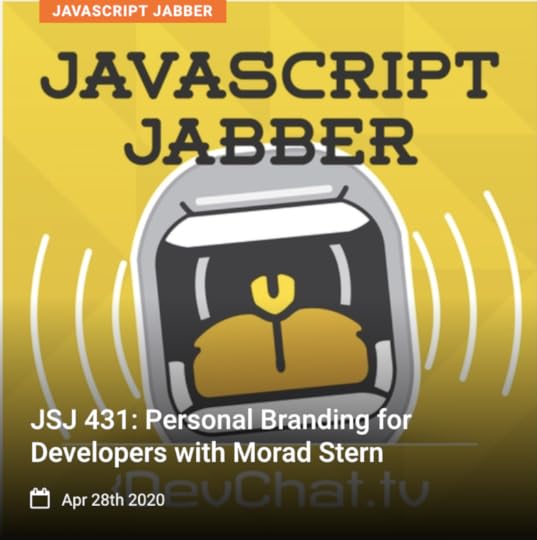
Last month I was interview for the popular JS Jabber podcast on the topic of personal branding for developers.
Here are some of the topics we covered:
What is personal brandingWhat can we learn from top brands like Apple, Nike and Coca-Cola when we talk about personal brandingThe set of mind of being active, not passive. Creator, not only consumer. Watch former president Barack Obama’s wise words about it:https://medium.com/media/4f19b67d307980577ad9f904190c803a/hrefWhy should developers, having high-demand skills in their hands, should care about personal brandingThe platforms and the opportunities that different developers can start engaging: From online to offlineTaking an active part in the community as a learning toolDan Abramov was not born as @dan_abramov with 246.7K Followers, he also had his first steps in growing and building influenceNetworking and reaching out to the unreachablePersonal branding as a journey of developing soft skills (communication, writing, public speaking)Fighting the “everyone know this” way-of-thinkingOK, I want this. How do I start?Listen here: https://devchat.tv/js-jabber/jsj-431-personal-branding-for-developers-with-morad-stern/
Feel free to share, contact on LinkedIn or follow on Twitter
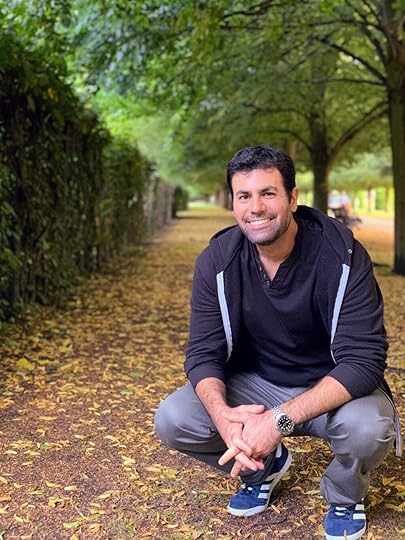 [image error]
[image error]
April 29, 2020
How to Master the Numbers Behind Your Telegram Channel: The Complete Guide for Telegram’s…
 Telegram Logo
Telegram LogoIf You Can’t Measure It, You Can’t Improve It. Peter Drucker
I love using Telegram. It is fast and it is rich with options, but on top of all — it includes the great feature of following and creating channels.
Having your own channel enables you to craft an unlimited, one-way, communication tool that bears a tremendous potential, if you do this right.
If you want to know more about about launching your own Telegram channel read: This is How You Can Build Your own Powerful Communications Channel on Telegram)
Ladies and gentlemens, I give you… channels statistics!
One of Telegram’s latest, and coolest, updates is the ability to view the behind-the-scenes of Telegram channel with an impressive number of stats and information that Telegram collects.
In this article, I will explain the various statistics that every Telegram channel manager should be familiar with.
“I have a Telegram channel, but why should I care?”
Because until now, you knew nothing about your subscribers, besides their usernames and ‘last seen’ data. Like you can see here (I removed the names, of course)
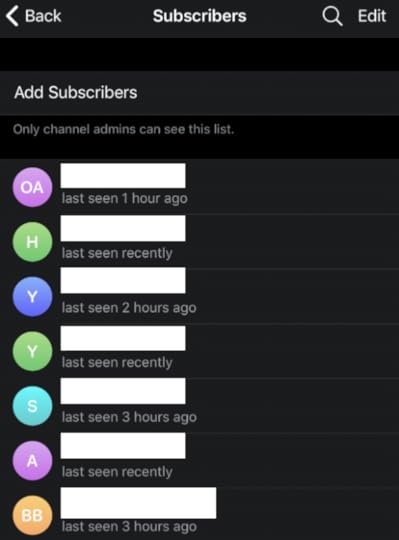
Knowing your Telegram channel’s statistics allows you to understand your subscribers much, much, better, and it’s important to follow the stats and understand their meanings, If you want your channel to grow, gain more visibility and have a bigger impact.
https://medium.com/media/09111d82159fbc67aa54e26ee3f223c4/hrefBut before we start, three important comments:
The stats option is available only in channels with 1,000 or more subscribersThe statistics option is relatively new, and I didn’t find many guides explaining it in depth. Much of the data is fairly straightforward to understand. However, the accuracy is turning more challenging in the following data: Sources of Obtaining Subscriptions and Viewing Sources. We will review them deeply later onAll the stats I present in this guide are from my Telegram channel, “Israel Tech & Innovation Forum”. (Hebrew)Let’s roll!
Entering your channel’s statistics page is very simple:
Enter your channelClick on top of your channel (where your channel’s name is presented)Click on the three-point buttonChoose the “Stats” option (and not “Delete Channel”!) — and you’re inWeekly Overview
After entering your channel’s stats page you’ll first see the weekly overview:
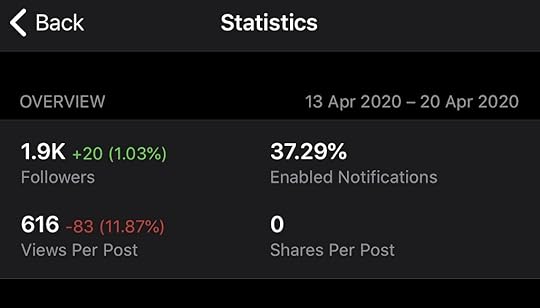 Subscribers (for some reason this is referred to as “followers”) — how many people (or more accurate, Telegram accounts) subscribed to your channelViews Per Post — What is the average number of post’s views during the last week. Post is every update you publish on your channel% of subscribers that allows receiving notifications from you — a very important information that actually lets you understand how many people are willing to get notified by your messages during the dayShares Per Post — a very important statistic. We’ll review this deeper later on
Subscribers (for some reason this is referred to as “followers”) — how many people (or more accurate, Telegram accounts) subscribed to your channelViews Per Post — What is the average number of post’s views during the last week. Post is every update you publish on your channel% of subscribers that allows receiving notifications from you — a very important information that actually lets you understand how many people are willing to get notified by your messages during the dayShares Per Post — a very important statistic. We’ll review this deeper later onChannel’s Growth
Telegram lets you see your channel’s growth rate in terms of subscribers. Telegram made this graph (and most of the other graphs in the stats page) interactive, which means you can play and adjust the time period and the time-view. Just play with the smartphone-like button at the bottom of the graph. Watch this:
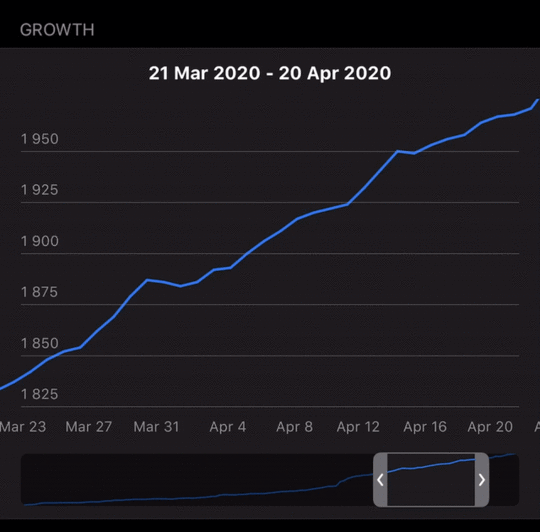
Aside from the rise you’ll see (unless you did a very poor job and people keep leaving your channel), you should pay attention to spikes (many new subscribers at the same day), and try to see what happened on that date. You can get a deeper picture in the following graph of ‘Followers’.
Followers
In this graph you can see how many subscribers left your channel (red) and how many (green) joined it, every day:
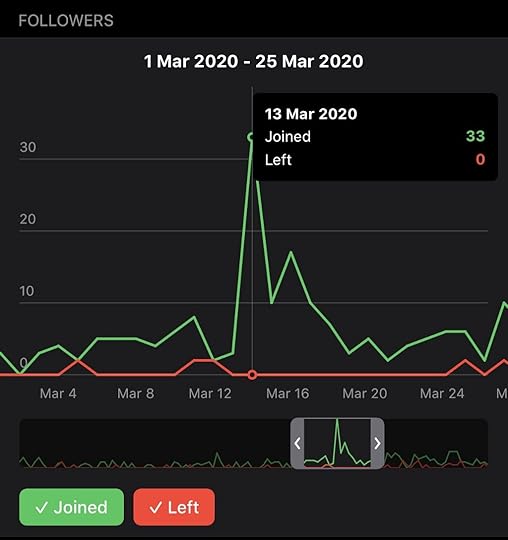
In this example you can noticed a very significant jump in which 33 people joined at the same day, which means it’s worth going back to that date (plus a day or two back) and understand what led to this jump.
Was it an update that was particularly important and shared by different people? or maybe your channel was mentioned on a well-known website or blog? It’s important to know what happened so we leverage and fully understand your audience and where it came from.
Notifications
Here you can see how many people have muted or unmuted your channel. In this example you can see that on the same day 11 subscribers muted my channel and two enabled notifications.
Same as before, it’s worth going back to this day and understand why a certain message (or more) led to that result:
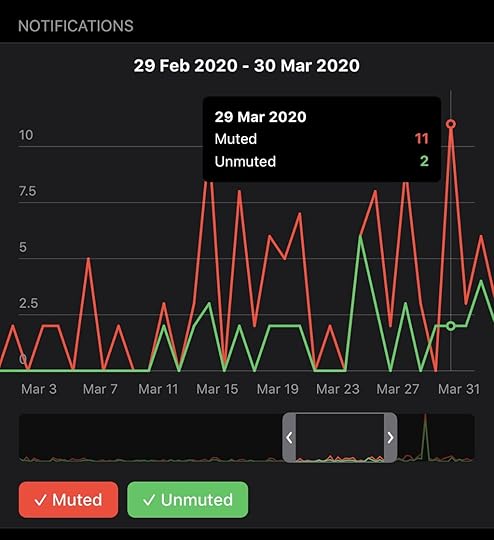
Views Times
What is the time in which your audience is most responsive and alert to your messages? Telegram displays a week-vs-week view, so you can compare and learn more about your their behaviour:
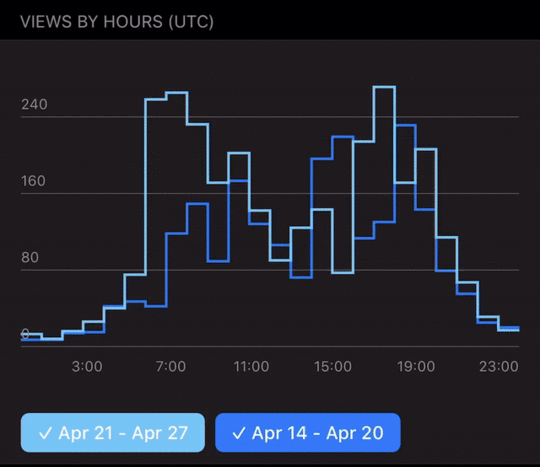
Viewing Sources
This is where the data can be a bit complex. The idea in these graphs is to understand where your posts are getting views from:
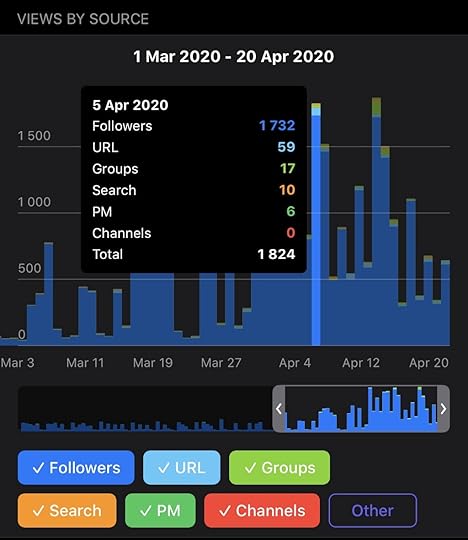
Viewing sources can be:
Channel subscribers — it goes without saying that most of your views will come from the within channel itselfGetting views from using a link — One of the best things about Telegram is the fact that every post has it own link that you share on social networks (or embed)Personal Message — Note that Telegram uses “PM” — private messaging as opposed to the more familiar shortcut “DM” — direct message. Interesting info that allows you to see how many of your posts are being sent as private messages (great indicator for making a great job and bringing valuable content to your channel)Channels — If a Telegram channel shared your message, here you will see the views that were gained from itGroups — If your message was shared in a Telegram group, here you will see the views that were gained from itSearch —the Search viewing source is when a user finds your channel with the global search bar, opens it and views the postsOther — I have no idea, still trying to learn itSources of Obtaining Subscriptions
Just as with Viewing Sources, this is another case of the data that is a bit unclear. But, just like ‘Viewing Sources’, by looking into those numbers you will understand where your subscribers are coming from, which is super important in order to continue and expand your channel’s audience:
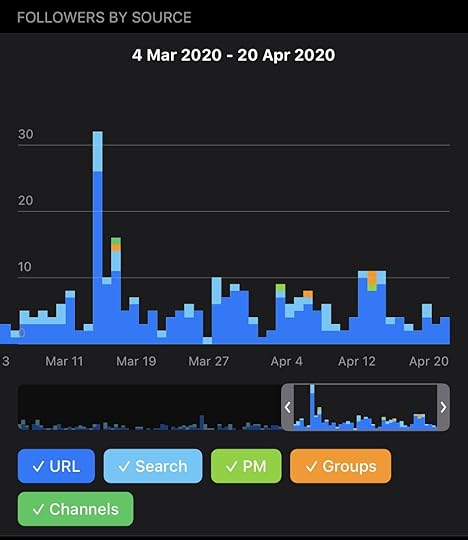
language
Here you can learn what is the preferred language of your subscribers. Because all the messages I publish on my channel are in Hebrew and the data shows 67% English, I can only assume that Telegram present the preferred interface language of the subscriber’s Telegram app. Which may (may) indicates the country in which the subscriber lives:
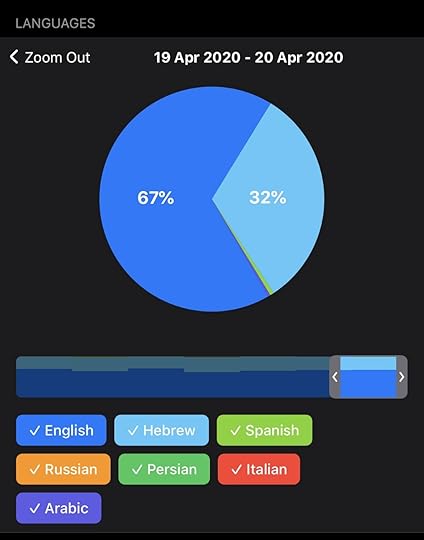
Interactions With Your Telegram Posts
Now this is getting really interesting — here you can learn what your subscribers are doing with the messages you publish in your channel.
Since my channel is a one-way communication channel (you can setup a mirror channel with open discussion or enable comments bot. I prefer to keep it clean), the options that are available to my subscribers are:
Read the message (or ignore it)Share it further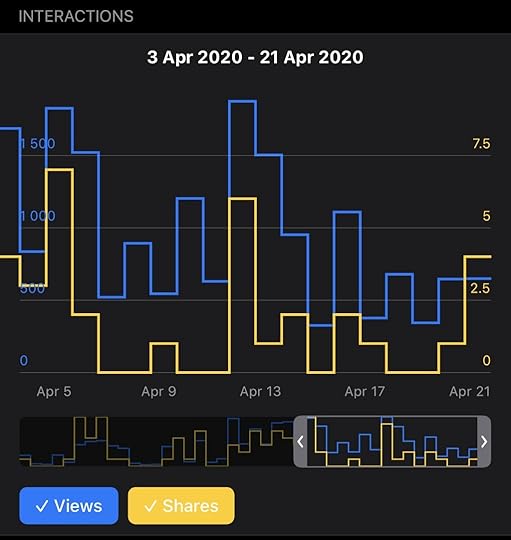
And that’s an important point: Telegram has no Sharing, there’s Forward.
Views and Forwards: Post by post
Ok, we’ve reached the bottom of the stats page. Here you can see the Views & Forwards on your channel, but from your post-by-post point of view, and get a better understanding of what content is considered more valuable (more forwards) which, again, will give you a better understanding of your audience:
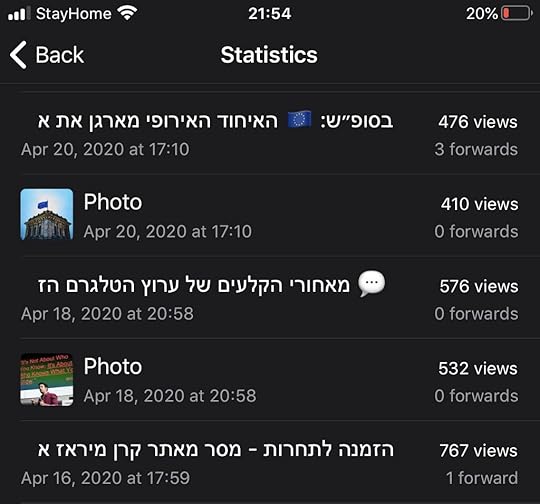
Summary
As said, knowing your Telegram channel statistics allows you to know your audience better, and it’s important to follow the stats and understand their meanings, if you want your channel to grow, gain more visibility and have a bigger impact on your subscribers.
Here are some of the things you can learn from the statistics of the Telegram channels we just reviewed:
Times — When to send a message during the day and when not toSignature — If people are sharing your message — you might want to add another signature with a link to your channelLinks — It is important to take advantage of the option that each one of your message has an independent link and allow more people to be exposed to it directly (works even if they do not have a telegram account!). Here you can learn how to embed a telegram message on websites.Your audience characteristics — by tracking and understanding the type of messages that received most of your channel’s attention (‘Views’ and ‘Forwards’’)as well as noticing jumps in joining rate (‘Growth’), you can access and search the network (or Telegram itself) and try to understand what happened.Percentage of subscribers that allows receiving notifications from you — from this stats you can understand how many people will be immediately exposed to a message you just sent, as well as gain an additional understanding of audience characteristics and how they perceive the value of your content.Meaning, if your content is important to them, and maybe they want to get your messages as soon as you publish them, they will not mute your channel.
Hope you enjoyed and learned from reading this guide, and feel free to ask me questions by using the comments option. And of course, you’re more than welcome to share this article.
This me on LinkedIn, on Twitter, and this is my Telegram Channel (Hebrew)
Nice update: Telegram liked this guide (or at least the Hebrew version of it) and here is their response:
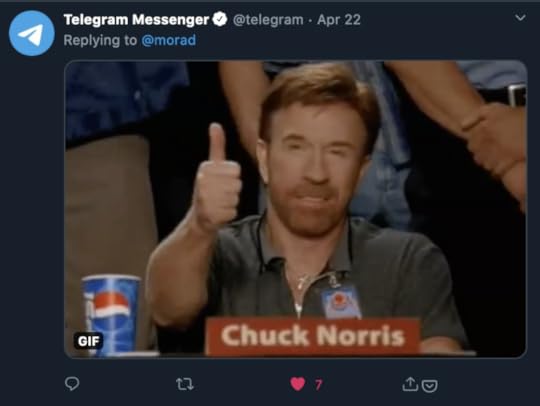 [image error]
[image error]
December 10, 2019
Networking, Personal Brand and Reaching Out to the Unreachable: 5 Insights From my Talk at…
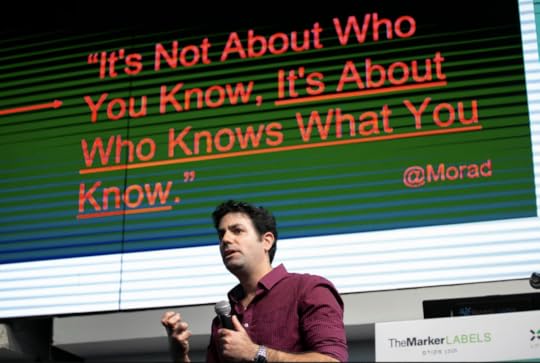
It’s not about who you know, it’s about who knows what you know
Two weeks ago I had the honor to give my talk “The Why and How Behind Building your Professional Brand and Creating Real Impact” at the “Employer Brand Leadership 2019” conference. The conference attracted hundreds of people and was held in collaboration with “TheMarker”, one of the leading news sites in Israel.
My speech was about what I learned and what impact did I see in my own journey of community and personal branding activities in the last five years.
Here are 5 insights I chose to share with the audience:
1# Networking: Let’s start with the phrase shown in the picture. Unfortunately, many people are familiar with the sentence: “It’s not what you know, it’s who you know”. I’m sorry, but, this sentence is shallow, misleading and does great harm. It may have been true, somewhere in the past, today it is important to realize that it evolved to — “It’s not about who you know, it’s about who knows what you know”.
With way more emphasis on your professional knowledge, and the way more attention to the way you are perceived in your industry. Networking with depth.
2 #No one will take care of your personal brand: Like always — if you don’t take care of yourself — no one will. Strong brands and organisations have people who take care and nurture their brand. Who takes care of your own brand?
3 # Hands-on. Always hands-on: Taking care of your personal brand require you to be very active and learn new skills. From content creation to community management, communication, marketing efforts and more. The more you try — the more you will know.
Just recently, I started learning video creation and editing. Watch this video I created for the Forum I led on my free time, “Tech and Innovation Forum” (Telegram, Hebrew), that helps me to share some tech related updates for my community:
https://medium.com/media/76610e1d1a58b09269561b635da787c2/hrefThe more you do, the more you know. The more you try, the more mistakes you do and learn from. The more mistakes you make (again, on your personal activities) — the greater experience and value you can bring to your organisation.
4 # No “Stop! border in front of you!” sign: In the digital world, if you act right and add real and valuable content with the community — you can reach out to anyone. Anyone.
In my talk, I shared with the audience, how I reached out to former US president, Barack Obama’s senior assistant, how I interviewed Hilary Clinton’s senior innovation advisor when she was Secretary of State, as well as many more other who considered to be unapproachable.

5 # Your personal branding — leveraged back at you daily work: About six months ago I was asked by a delegation of student from Finland to announce about their visit in Israel on my “Tech and Innovation Forum” (Telegram, Hebrew). Their goal was to get familiar with the Israeli high-tech industry and hear the story of the Startup-Nation.
I was happy to help. I also invited them to visit our Wix offices in Tel-Aviv. Now, here’s a question for you: can you guess which company took a significant part of the Startup-Nation story they experienced?..
Now, here’s a question for you: can you guess which company took a significant part of the Startup-Nation story they experienced?..
And, of course, stories always move on — I shared a photo with the audience, showing the students from that delegation in our offices, and then back at their university in Finland, where they shared what they heard and what they learned with the other students:
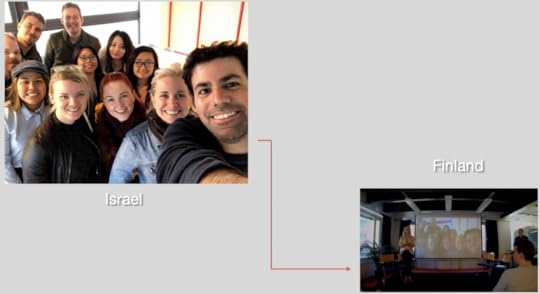
I really hope you liked, this insights. Here are the slides from my talk, “The Why and How Behind Building your Professional Brand and Creating Real Impact”.
- Feel free to contact me on LinkedIn or Twitter![image error]
May 3, 2019
Your Company’s Community Manager Role: 7 Important Insights
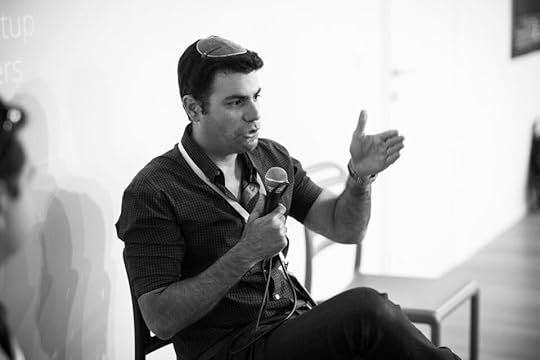
A year ago, as part of IS-CL Summit (community management event taking place in Israel), I was interviewed about the activities we lead at Wix, regarding developers communities. Here are seven role-related points about the community manager position, that I have mentioned in that interview:
The community manager role #1 — This role requires deep understanding in many areas of knowledge in which the relevant community is involved. Since we are living in times in which professional knowledge is expanding on daily basis — constant learning must be part of your daily community manger routine.The community manager role #2 — The role of a community manager is also very broad and very representative role. It is very broad and wide since more and more departments in organisations want to take part in community related activities (activities that are mostly very organic, positive, and therefore are easy to connect to. See point #7). And it is also a very representative role because sometimes your community manager will be the one who leads meetups or events, participate in different conferences or create partnerships with another organisation or a parallel community.No matter what you do, and no matter what industry you’re part of — the main point is always about the value, but it is important to research and find the accurate value for to the members of the community. Each community has a different set of interest and a different meaning for what is considered to be valuable. The more accurate we are in defining the community — the better we understand what it’s members find as valuable. And, if we do that research really good and really deep, we will also be able to unveil several sub-communities inside that community.Understand the importance of your community culture — what motivates the community members? what makes them Tick? what are their culture’s related brands? (from TV shows to news sites, platforms, events, conferences, important dates and thought leaders).Internal communication — the invisible channels — many communities have an external appearance (mostly online), but it is also important to pay attention to the more subtle channels behind the scenes. These channels are the internal communication channels, which are often the tools to really engage and influence the community.The role of “community manager” seems to gain more and more workforce momentum. Currently, mostly in the high-tech industry but not only. I think it’s great, in the next section I’ll explain why.The world of communities, in my opinion, is an enlightened development of the traditional Marketing world. Moving from creation and distribution of selling and advertising messages — to sharing knowledge, experience, and value (see point #2). It’s great because these kinds of activities, at least when properly done, enrich the industry, connect people with each other, and give a lot of emphasis on personal and professional growth.Feel free to connect on LinkedIn or follow more tech, branding and communities updates on Twitter .
[image error]February 21, 2017
This is How I Launched an Official Channel Between the Government and the Tech Industry
 Photo Credit: Zaheer Mohiuddin, Flickr CC
Photo Credit: Zaheer Mohiuddin, Flickr CCA year ago, in my role as Hewlett Packard Enterprise’s global dev communities manager, I invited 2 VIP representatives from GitHub for a full day conference with our developers. We managed to pull off an amazing event with awesome content covering open source and cutting-edge technology.
But,
I was frustrated that these 2 VIP representatives flew all the way from San-Francisco to Israel and I had no direct channel to inform the government about this visit, enabling relevant government officials to enjoy the company, knowledge and connections of these two unique guests.
From frustration to solutionI contacted a talented senior from the Israeli Ministry of Foreign Affairs. I told him this story and how wrong it is to have no official channel that can enable the industry to:
Inform the government about VIP tech guests that visit IsraelShare updates about important tech conferences that have global impactI offered my help in building a new channel just for that — and, YAY, I got a green light!
So, here it is: “Tech and Innovation Forum: Ministry of Foreign Affairs”The “Tech and Innovation Forum: Ministry of Foreign Affairs” launched a month and a half ago. For the first step in building this channel / community I decided to start with a simple text newsletter. The most plain-non-sophisticated newsletter you’ve ever seen, but, one with valuable updates. This is how it looks:
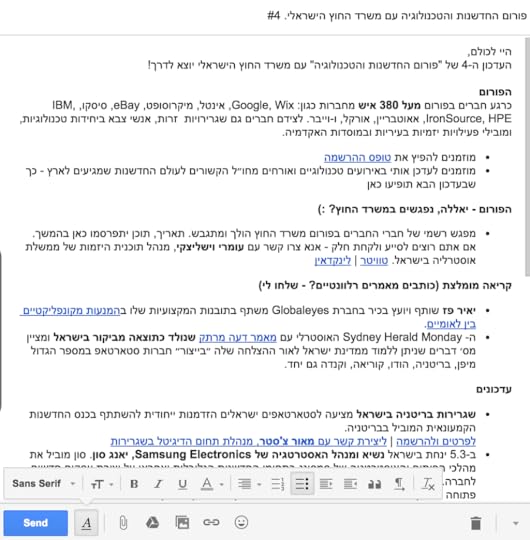
After just one Facebook status (calling people to join as well as to send me relevant updates) plus one simple Google docs form for registration — we were set to go!
Here’s what this tech-government forum already achieved:
Almost 400 people from companies and organization such as: Wix, Deloitte, Google, eBay, IBM, Cisco, Oracle, Microsoft along with army tech divisions, municipal innovation departments and universities entrepreneurship programs — have already signed as subscribersI was invited to be a guest in Google’s official entrepreneurship podcast (!) to talk about the new forumI got messages and updates from Israel foreign embassies from around the world as they are now following the forum (how exciting!)4 newsletters have already been sent covering more than 15 events, VIP guests visiting Israel and global entrepreneurship programsPersonal-professional connections were created between seniors and well-known global organizations because of this channel (YAY! real impact)Members (subscribers) of the new forum will be invited to take part in a meeting that will be held in the Ministry of Foreign Affairs’ officesConclusionFrom taking action and building up this kind of channel I managed to extract 3 main lessons (they are almost identical to the lessons I learned when I created Israel’s fire map with the Israeli Air Force)
Be that someone who take an active part: I didn’t have this kind of communication with the government — so I built oneNo need for title: I have no official title in international relations or building industry updates forums or communication channels, but it did not stop me from launching this initiativeThe most important thing is value: The newsletter is not a fancy one. Just plain text. However, when you solve a real problem and deliver great value — it almost doesn’t matter.Want to join & help?Tech & Innovation Forum — Signing formFeel free to contact mePhoto Credit: Zaheer Mohiuddin, Flickr CC
[image error]


